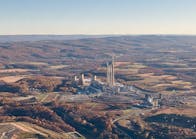Moving Beyond Early Adopters: Q&A on the Microgrid Future with Smart Grid leader Mark Feasel of Schneider Electric
Reliability is a destination.
Microgrids are the ultimate backup plan for mission critical energy users such as military bases, public safety facilities, health care and university R&D. They have always existed, as one could call the stand-by diesel generator an on-site system of its own.
Yet the call for not only resiliency, but also net-zero emissions goals, is picking up momentum and microgrids are evolving both in advance of and in reaction to this movement. Given the current era’s double whammy of an aging transmission infrastructure and the increasing frequency of climate disasters, microgrids are in demand and responsive to sustainability goals as never before.
EnergyTech chatted with Mark Feasel, president of Schneider Electric’s Smart Grid North America division and himself a longtime veteran steeped in microgrid nuances. The Q&A, conducted via email by Senior Editor Rod Walton, touched on many microgrid projects involving Schneider Electric and its partners, but also future picture and potential headwinds for the microgrid industry.
--- ---
EnergyTech: Microgrids are hardly niche anymore. Just recently the U.S. Army’s Climate Strategy called for a microgrid at every installation by 2035. . . Do you see huge potential for island-able power generation on-site at public facilities and for how long will that momentum hold?
Mark Feasel: “Yes, and the momentum is only going to accelerate in the immediate future. As people begin to understand more about the energy that they're using, they recognize gaps between what's provided by the centralized grid today and what they can generate locally.
“The important point here is that past island-able microgrids basically required some kind of fossil fuel generation, generally diesel. Now, modern microgrids can be fully island-able using only solar plus batteries or less carbon-intensive generation sources like fuel cells or reciprocating gas engines.
“The recent climate strategy from the Army demonstrates that we’re moving beyond the early adopters and into municipalities and other public and private sectors. Renewable energy and island-able power generation has penetrated bakeries, bus stations, pharmaceuticals, municipalities and more.”
EnergyTech: One of your big projects with Schneider Electric was the Port of Long Beach. Can you give us some specifics on the scale and components of that particular microgrid and why it’s so important? I mean, we’ve heard a lot about the port in dealing with supply chain shortages in the economy, so what does a microgrid provide there?
Feasel: “There were a couple phases associated with this unique project. Automating its largest terminal gave Port of Long Beach the ability to operate cranes, oversee truck deliveries, monitor the weighing of cargo, and much more via software. This contributed significantly to safe port operations enabling personnel to operate cranes remotely in bad weather.
“The first phase of that solution was the ships themselves needed to be powered from shore instead of providing their own power because they burn fossil fuels. The state of California wanted to shift away from fossil fuels as a primary energy source to deliver on state sustainability goals. In order to do that, the infrastructure had to be put in place.
“The first phase was to shut down the ships and electrify that process – then the ports. This led to additional innovation with other aspects like cranes, tubs, logistics equipment and more. And though this was a move in the right direction for cutting back on fossil fuels, it was not met without its challenges. Understanding what operations had specific lines of power was important to keep things running efficiently, and certainly in the event of an outage.
“It also has more predictable energy costs because you are providing more of the energy from renewable sources, which has no fuel cost from natural gases. Fuel prices are more stable with increased solar sources. The third thing though is that it decarbonizes the supply chain of whomever they're supporting, and this can be important because those companies that they're moving goods for are looking to perhaps reduce their carbon footprint. This offers a differentiating factor of this support which could help businesses viability of the port.”
EnergyTech: I remember writing about some of SE’s microgrid projects for public safety sites some five years ago or more ago. Now there are a lot of companies getting into this space. Do you see any danger of oversaturation of the microgrid solution and, if so, why?
Feasel: “Absolutely not. It's still a nascent, early stage market. Most buildings and customers are on the journey of discovering more now and then deciding what to do in the future. So, we're nowhere near that stage of oversaturation.”
EnergyTech: Inverter-based generation is all the rage, but it’s not as simple as we think from the consumer side of things. What are some challenges and even outright barriers to installing microgrids?
Feasel: “It sets up a false premise, honestly. The truth is that, yes, inverter-based solutions require different technical approach to solve them, but ultimately, they're still solvable.
“Solar and wind plus storage (prices) continues to drop precipitously, which means that we're seeing more and more of it. It also means that our solutions must take that into account. It's a different technical solution, for example.
“As you move to inverter-based resources, you still must have something that the technical solution must be able to maintain. Frequency and voltage can be stabilized leveraging battery energy storage or connecting to other generating sources, like fuel cells or gas engines.
“There are challenges and it is a different path technology story than it was five years ago, or they look different than microgrids. But the problem is well within a domain of technology to solve.
“Running a diesel generator for full time loads, for example, isn’t cost effective and its violation of sustainability and clean air policy. Natural gas and fuel cells, on the other hand, can certainly be run all the time with the right kind of emissions monitoring and equipment.”
Related stories
Schneider developing $22.5M Microgrid at Air Force base in Florida
What You should know about Microgrids?
EnergyTech: What is the learning curve? Do we really understand how bidirectional energy resources truly behave? Can this perceived rush to alternative energy and resiliency bite the hand that feeds it?
Feasel: “Along with this proliferation of mistreatment of renewable energy resources is another very important phenomena occurring--that's digitization of energy. We are sensing and analyzing energy to a degree that that didn't occur 10 to 15 years ago and it's only through that digitization that we can leverage modern tools like Hi L hardware in the loop.
“We can simulate how systems are going to act without anything attached to it today. And then, we can model these systems with data and have AI that runs while the grid is operating to improve how it functions in the future.
“We need to do this at the same time. This is why we are focusing heavily on digitization. If we don’t focus on digitization, then leverage and learn from the resulting data, we are not going to get the full benefit of the technology through this transition.”
EnergyTech: So many commercial and industrial customers are seeking both sustainability and energy resiliency, especially in the wake of climate disasters too numerous to mention. What can a microgrid provide that an on-site combined heat and power plant cannot?
Feasel: “A combined heat and power plant is often a key part of a microgrid. A microgrid would in general extend the functionality of a more simplistic unit by bringing in external price signals and allowing it to solve for grid price or bringing in a sustainability signal from a market and solving energy supply from a sustainability point of view. So, they're not opposed to each other at all.
“Many microgrids have CHPs, but this would entail more advanced connectivity to the grid than a simple, standalone on-site heat and power unit.”
EnergyTech: Can CHP and renewables-storage-based micro generation co-exist? If so, does it really help on the road to Net Zero?
Feasel: “Absolutely. Most natural gas solutions are on average 30% greener than the bulk power grid. Any kWh displacing by having on site CHP pick that up is great. And if we accelerate that by combining power and solar to improve sustainability, resilience and cost for that community.”
-- -- --
(Rod Walton, senior editor for EnergyTech, is a 14-year veteran of covering the energy industry both as a newspaper and trade journalist. He can reached at [email protected]).






